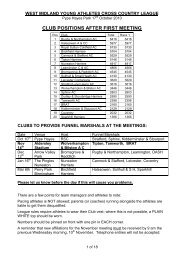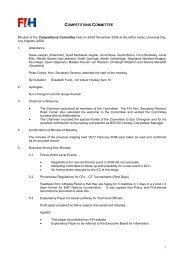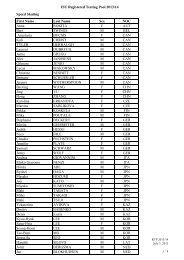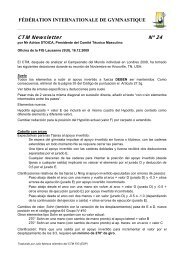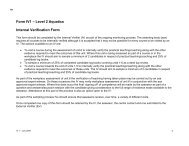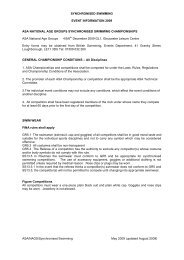Olympic Media Guide 5/8/04 - sportcentric
Olympic Media Guide 5/8/04 - sportcentric
Olympic Media Guide 5/8/04 - sportcentric
- No tags were found...
You also want an ePaper? Increase the reach of your titles
YUMPU automatically turns print PDFs into web optimized ePapers that Google loves.
NEWCOMER’S GUIDE TO SWIMMINGSwimmers often talk using their own abbreviations and words that don’t apply to the outside world.Below is a simple glossary of some of these terms:PB – Personal Best timeSplits – The time at each 50m turn. Swimmers will monitor these to check how they paced a race.Taper – A swimmer will “taper” prior to any big competition. All this really means is that they rest. They will cut backthe amount of training they do and decrease the intensity. While a swimmer may swim over 12,000metres a day duringheavy training, they will swim as little as a few hundred metres the day before an event.Free – Freestyle or front crawl.Breast – Breaststroke.Fly – Butterfly.Back – Backstroke.IM – Individual Medley (Butterfly, Backstroke, Breaststroke, Freestyle). At the World Championships there is a 200mIM (where the swimmer will swim 50m of each stroke in the order above) and a 400m IM (100m of each stroke inorder). Note that in a Medley relay, the order is changed so that backstroke is first. This addresses the fact thatbackstrokers can’t do a dive to take over. Four swimmers complete 100m each in the following order: Backstroke,Breaststroke, Butterfly, Freestyle.Swim-down – A recovery exercise which takes place several minutes after a swimmer completes his/her race.Competitors will swim at a low intensity in another pool in order to rid their body of lactic acid, which accumulatesin the muscles following high-intensity performances.Long Course – The <strong>Olympic</strong> Games are being held in long course format. This means that all events take place in a 50mpool. Short Course events are those held in a 25m pool. Short course times are faster than long course times becausethe swimmer completes more turns and can take advantage of the propulsion generated from pushing offthe wall.Shaving-down – Most swimmers shave the hair from their bodies for a big meet. Although they will removealmost all of their body hair, the actual purpose is to remove the top layer of skin. This increases the sensitivity and“feel” for the water. Even though a lot of swimmers will wear all-over body suits at the <strong>Olympic</strong> Games, shavingwill remain an important psychological step in getting ready for a race.The eight fastest swimmers from the heats will swim in the final. For the 50m, 100m and 200m events there will betwo semi-finals as well as heats. These are swum in the finals sessions and the eight fastest swimmers from thesemi-finals will go through to the final the following night.The lane order for finals is decided from times in the heats or semi-finals. The fastest qualifier will swim in lane 4,second fastest in lane 5, third in lane 3, fourth in lane 6, fifth in lane 2, sixth in lane 7, seventh in lane 1 and eighthin lane 8. Theoretically, this creates a spearhead format in the race.During the <strong>Olympic</strong> Games the one-start rule will apply. If any swimmer performs a false start they will bedisqualified from the race. A false start can involve falling in or moving before the gun. Swimmers must be still forthe start. Any swimmer moving before the start will be disqualified at the end of the race and the start should goahead regardless of the disqualification.41



